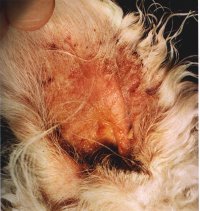 Back
Back
EAR
INFECTION (Otitis)
First broadcast on www.provet.co.uk |
This information is provided by Provet for educational purposes only.
You should seek the advice of your veterinarian if your pet is ill as only he or she can correctly advise on the diagnosis and recommend the treatment that is most appropriate for your pet.
Ear infections are extremely common in dogs, cats, rabbits and other species. If untreated they can result in deafness or even brain disease.
The signs of ear infection include :
- A visible, often smelly, discharge from the outer ear canal . This can be almost any colour - black, brown, reddish-brown, red, yellow, off-white.
- Reddening of the skin on the ear flap
- Thickening of the skin on the ear flap
- Scratching the affected ear(s)
- Drooping of the affected ear(s)
- Narrowing of the ear canal- sometimes it is almost completely closed off
- Head shaking
- Walking in circles
- Fitting

Acute ear infection in a 4 year old poodle
The signs generally get worse as the infection moves from the outer ear canal (called otitis externa) through the middle ear (otitis media) and finally to the inner ear (otitis interna). Infection of the middle and/or inner ear can occur without the external ear canal being involved. Severe cases may result in deafness.
Sometimes the infection is caused by a foreign object down the ear such as grass awns, in which case it (or they!) must be removed.
Ear infection causes great discomfort (as anyone who has ever had an earache can testify) - so prompt treatment is necessary. Although a build up of wax in the outer ear canal can be softened and removed using over-the-counter preparations from a chemist, there are many underlying causes of ear infection including :
- Foreign objects
- Allergies
- Immune deficiency
- Cancer in the ear canal
so, a full examination by your veterinarian is necessary to eliminate these possible causes.
The infection itself may be due to a variety of bacteria or yeasts or parasites (ear mites) and specific treatment is needed.
If you see a foreign body in the ear of your pet never try to remove it - it could be attached, or penetrate the ear drum, and great care should be used to remove it to avoid causing further damage. Often a general anaesthetic is needed to save the animal unnecessary pain.
Feedback Request
If you have had a pet with grass awns in the ear canals how many were removed ? If your veterinarian removed more than 10 let us know by e-mail at feedback@provet.co.uk
Updated October 2013